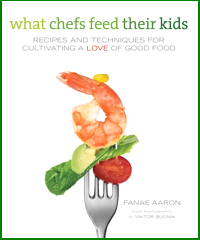
If you have an adventurous child, especially in food, chances are other parents will want to know your secret. How do we get our kids to like the foods we want them to eat?
How do we encourage them to have the same curiosity they might have in reading a new book, or learning a new concept, in what they eat?
Fanae Aaron decided to ask experts. What Chefs Feed Their Kids: Recipes and Techniques for Cultivating a Love of Good Food (Lyons 2011) is the result of her desire to make sure her son learned to eat well.
This book illustrates their strategies and their attitudes; it’s not just about cooking for your kids. I know enjoy cooking family meals, but the techniques are the same for eating out .It’s about how we educate our kids, and eventually how we enable them, when they are old enough, to make better choices for nourishing themselves. (pp. vii-viii)
Her book covers infancy to adolescence (8-11) with recipes by chefs and profiles of chefs and their kids. There is a lot of advice about how to encourage babies and kids’ curiosity, encouraging them to cook and clean up, and understand where food comes from. Many of the recipes are meant for adults, or can be part of an adult meal.
 The first chapter covers purees like BT Nguyen‘s Pumpkin Soup with Coconut, Peanuts and Scallions (p. 24) and Piero Selvaggio‘s Roast Chicken with Potatoes and Kale (p. 28) that can be eaten as is for adults, and pureed for infants. After Purees, the following chapter for children one to two-and-a-half, includes some very smart advice from chefs like not emphasizing your own food dislikes with your kids, or take kids to your local farmers market. Diane Forley and Michael Otsuka of Flouish Bakery take their daughter to their local market, ” Olivia can identify a lot of foods and ingredients from having shopped with her at an early age at the farmer’s market and the grocery store. ‘She can identify arugala.'” Cathal Armstrong encourages choice:
The first chapter covers purees like BT Nguyen‘s Pumpkin Soup with Coconut, Peanuts and Scallions (p. 24) and Piero Selvaggio‘s Roast Chicken with Potatoes and Kale (p. 28) that can be eaten as is for adults, and pureed for infants. After Purees, the following chapter for children one to two-and-a-half, includes some very smart advice from chefs like not emphasizing your own food dislikes with your kids, or take kids to your local farmers market. Diane Forley and Michael Otsuka of Flouish Bakery take their daughter to their local market, ” Olivia can identify a lot of foods and ingredients from having shopped with her at an early age at the farmer’s market and the grocery store. ‘She can identify arugala.'” Cathal Armstrong encourages choice:
Giving kids a choice and not always deciding for them–especial at two, when they go through that independent phase¬–is important; they can be really cranky during the terrible twos. I think allowing them those independent choices even at a young age is crucial. (p. 35)
Cathal says that being a good cook can help, especially when introducing tricky vegetables like Brussels sprouts.
There is a long discussion on picky eaters and food wars (pp. 38-42), with advice from chefs on getting kids to try a food more then a few times. Diane’s Ratatouille with Balsamic Vinegar, Honey, and Basil ( p. 56) adds sweetness to entice kids, while Jimmy Schmidt’s Cauliflower and Parmesan Macaroni (p. 62) is comfort food for both kids and adults. As the chapters progress, the food gets more complicated, spicier, and more adventurous.
The book contains fun pictures of chefs and their kids as well as photos of the dish by Victor Budnik. The recipes cover appetizers, main courses, and desserts. Let your kids look over the recipes and help you decide what to cook with them – that way they are more likely to want to eat and get excited about food.
